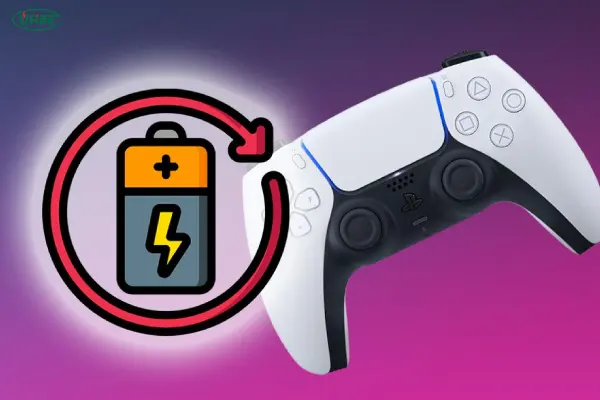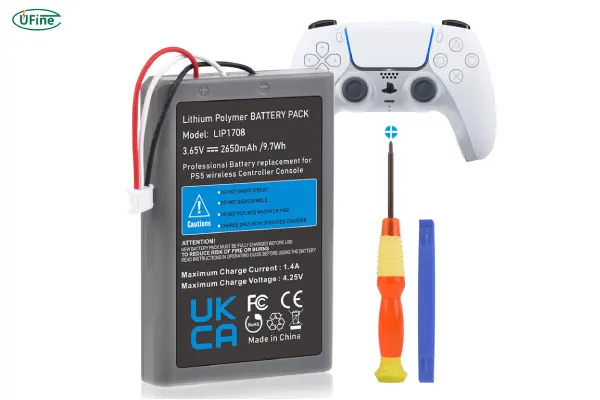
- Part 1. Why PS5 controller battery problems are a big deal
- Part 2. How the PS5 dual sense battery works
- Part 3. Key signs your PS5 controller battery is failing
- Part 4. Root causes behind battery problems
- Part 5. How to fix the most common PS5 battery issues
- Part 6. Replacing the PS5 controller battery
- Part 7. Best battery options for replacements
- Part 8. Long-term battery maintenance tips
- Part 9. When to seek professional help
- Part 10. Final thoughts
- Part 11. FAQs
If you’re a passionate gamer, you know the frustration when your PS5 controller runs out of battery in the middle of an intense session. The PS5 DualSense controller is a technological marvel, but its advanced features put significant demands on the battery. Over time, even a powerful lithium-ion battery can start to show signs of wear. That’s why understanding how to fix PS5 controller battery issues is crucial for any serious PlayStation gamer.
This comprehensive guide will help you understand the root causes of these battery problems, how to diagnose them, and—most importantly—how to fix or even replace the battery to restore full functionality.
Part 1. Why PS5 controller battery problems are a big deal

Your gaming experience depends on the responsiveness and longevity of your controller. When your PS5 controller’s battery fails, you face lags, interruptions, and constant recharging. Unlike older controllers, the DualSense uses an integrated battery that isn’t designed for easy replacement. This makes battery issues both common and inconvenient.
Part 2. How the PS5 dual sense battery works
The PS5 controller contains a built-in lithium-ion rechargeable battery. Here’s what you need to know:
- Type: Lithium-ion polymer (Li-Po)
- Voltage: 3.65V
- Capacity: Varies by model, typically between 1,560mAh and 2,200mAh
- Lifespan: About 500 full charge-discharge cycles
This battery powers all internal systems: adaptive triggers, haptic feedback, motion sensors, a microphone, and a light bar. These features are immersive but battery-intensive.
Over time, the battery’s ability to hold a charge diminishes. Partial charging, deep discharge, and exposure to heat also accelerate this degradation.
Part 3. Key signs your PS5 controller battery is failing
Before you start fixing anything, it’s essential to identify the problem. Here are typical signs of battery issues:
- Controller only works when plugged in: A classic sign of a dead or disconnected battery.
- Fast battery drain: It dies after just 1–2 hours.
- Inconsistent charging: It charges sporadically or disconnects frequently.
- No charge at all: Battery appears dead despite prolonged charging.
- Overheating: Battery or controller becomes warm while idle.
- Swollen battery: This is dangerous and must be replaced immediately.
Part 4. Root causes behind battery problems
Let’s go deeper into what might be going wrong:
A. Natural Degradation
Lithium-ion batteries degrade with each charge cycle. After 1–2 years of frequent use, it’s normal for battery performance to decline.
B. Charging Port or Cable Issues
A damaged USB-C cable or debris in the port can prevent proper charging. Always inspect your cables and clean the port gently with compressed air.
C. Firmware and Software Bugs
Sometimes, a system update can interrupt charging behavior. Resetting the controller or updating firmware may help.
D. Power Source Instability
Charging from a PC USB port or low-voltage adapter can slow charging. Use the PS5’s ports or a certified wall charger.
E. Hardware Defects
In rare cases, the battery or charging circuit may be defective from the start.
Part 5. How to fix the most common PS5 battery issues
Let’s get into practical solutions:
1. Controller Won’t Charge
- Test with another USB-C cable.
- Clean the USB port with a dry brush or compressed air.
- Try a different charging port on the PS5 or use a certified wall adapter.
- Reset the controller using the pinhole on the back.
- Update the system firmware.
2. Battery Drains Too Fast
- Go to Settings > Accessories > Controllers
- Set “Trigger Effect Intensity” and “Vibration Intensity” to low or off.
- Dim the light bar.
- Mute the built-in microphone.
- Enable rest mode charging in system settings.
These settings reduce the load on the battery and extend playtime.
Part 6. Replacing the PS5 controller battery
When fixes don’t work, replacement is your best bet. It’s not as difficult as you might think, though it requires care.
Tools Needed:
- Small Phillips screwdriver
- Plastic pry tool
- Replacement battery (same voltage, higher or similar capacity)
Step-by-Step Instructions:
- Turn off and unplug the controller.
- Remove the back cover screws hidden beneath the top shell.
- Carefully separate the shell using the plastic tool.
- Locate and unplug the old battery.
- Plug in the new battery, ensuring correct polarity.
- Reassemble the controller.
A high-capacity replacement battery can significantly improve playtime per charge.
Part 7. Best battery options for replacements
Look for the following when buying a battery:
- Same voltage (3.65V)
- Capacity: 2,200mAh or higher for better performance
- OEM Connector: Plug-and-play compatibility
- Certifications: CE, RoHS, UL
- Cycle Rating: 500+ for longer life
Ufine Battery, a top lithium battery manufacturer from China, offers custom battery solutions specifically for devices like gaming controllers. Whether you need ultra-thin batteries, high-rate cells, or high-temperature performance, Ufine has the technology to build custom power solutions.
Need a custom battery for your PS5 controller? Contact Ufine Battery to get a solution that fits your exact needs.
Part 8. Long-term battery maintenance tips
To extend your controller’s lifespan:
- Keep the battery between 20% and 80% charged
- Avoid extreme heat or freezing temperatures
- Don’t leave it charging overnight continuously
- Use official or certified charging cables
- Store the controller in a cool, dry place
These simple habits can slow down battery aging and prevent damage.
Part 9. When to seek professional help
Some situations call for expert intervention:
- Battery is physically swollen
- Controller doesn’t respond to resets
- Connector or circuit board appears damaged
Part 10. Final thoughts
PS5 controller battery issues are common, but they don’t have to be permanent. With the right knowledge and tools, you can solve most problems yourself. Whether it’s optimizing settings, performing a reset, or replacing the battery, these steps will help restore your gaming experience.
And remember, for advanced or custom battery needs, Ufine Battery is your go-to partner. Our range of lithium polymer, cylindrical, high-rate, and high-temperature batteries can be customized to fit any controller design.
Part 11. FAQs
Can I charge the PS5 controller while playing?
Yes, but avoid playing for long hours while it’s charging—this generates heat that can degrade the battery.
How long does the PS5 controller battery last?
6–12 hours per charge, depending on usage. Expect 2–3 years of reliable service.
Will replacing the battery void my warranty?
Yes. Disassembling the controller may void your warranty, so check your coverage first.
Are third-party batteries safe?
Yes, if you choose a certified manufacturer like Ufine Battery with a good safety record.
Why does my controller randomly shut off?
This could be due to overheating, a bad battery connection, or a firmware glitch.
Related Tags:
More Articles

Exploring the Lithium Ion Battery Fire Temperature
Discover the lithium-ion battery fire temperature and learn how to stay safe. Get essential tips to prevent battery fires and protect your devices today.
The Ultimate Guide to 6s Lipo Batteries
A beginner-friendly guide to 6S LiPo batteries. Understand voltage, capacity, charging tips, safety rules, and real-world applications.
What is the NCMA battery? What is the difference between it and the NMC battery? Which one is better? This article will answer your questions.
What Is the Lithium Battery Short Circuit?
What is the lithium battery short circuit? To understand a lithium battery short circuit, we first need to understand how the battery works.
How to Distinguish Battery Cells, Battery Modules, And Battery Packs?
Discover how battery cells, modules, and packs work, their engineering roles, and practical guidance for safe and efficient design.



